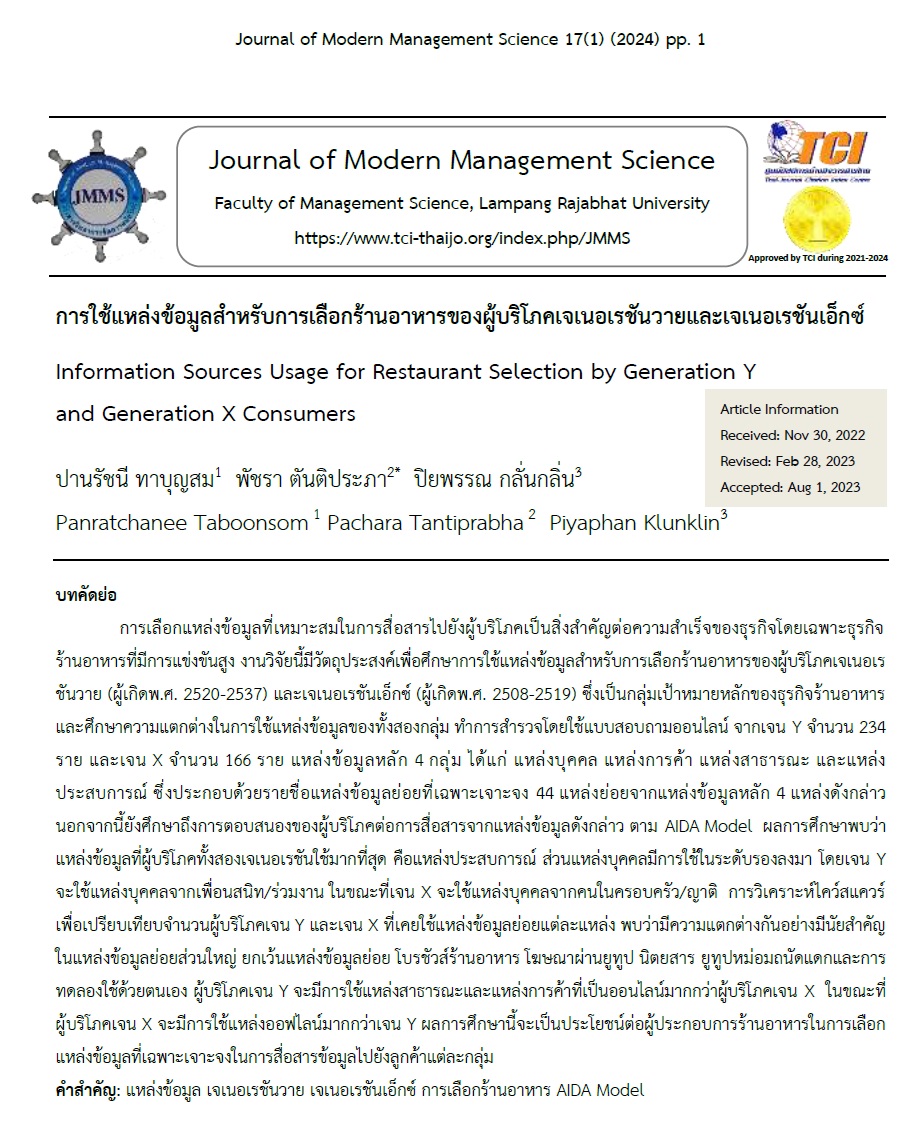การใช้แหล่งข้อมูลสำหรับการเลือกร้านอาหารของผู้บริโภคเจเนอเรชันวายและเจเนอเรชันเอ็กซ์
Main Article Content
บทคัดย่อ
การเลือกแหล่งข้อมูลที่เหมาะสมในการสื่อสารไปยังผู้บริโภคเป็นสิ่งสำคัญต่อความสำเร็จของธุรกิจโดยเฉพาะธุรกิจร้านอาหารที่มีการแข่งขันสูง งานวิจัยนี้มีวัตถุประสงค์เพื่อศึกษาการใช้แหล่งข้อมูลสำหรับการเลือกร้านอาหารของผู้บริโภคเจเนอเรชันวาย (ผู้เกิดพ.ศ. 2520-2537) และเจเนอเรชันเอ็กซ์ (ผู้เกิดพ.ศ. 2508-2519) ซึ่งเป็นกลุ่มเป้าหมายหลักของธุรกิจร้านอาหาร และศึกษาความแตกต่างในการใช้แหล่งข้อมูลของทั้งสองกลุ่ม ทำการสำรวจโดยใช้แบบสอบถามออนไลน์ จากเจน Y จำนวน 234 ราย และเจน X จำนวน 166 ราย แหล่งข้อมูลหลัก 4 กลุ่ม ได้แก่ แหล่งบุคคล แหล่งการค้า แหล่งสาธารณะ และแหล่งประสบการณ์ ซึ่งประกอบด้วยรายชื่อแหล่งข้อมูลย่อยที่เฉพาะเจาะจง 44 แหล่งย่อยจากแหล่งข้อมูลหลัก 4 แหล่งดังกล่าว นอกจากนี้ยังศึกษาถึงการตอบสนองของผู้บริโภคต่อการสื่อสารจากแหล่งข้อมูลดังกล่าว ตาม AIDA Model ผลการศึกษาพบว่าแหล่งข้อมูลที่ผู้บริโภคทั้งสองเจเนอเรชันใช้มากที่สุด คือแหล่งประสบการณ์ ส่วนแหล่งบุคคลมีการใช้ในระดับรองลงมา โดยเจน Y จะใช้แหล่งบุคคลจากเพื่อนสนิท/ร่วมงาน ในขณะที่เจน X จะใช้แหล่งบุคคลจากคนในครอบครัว/ญาติ การวิเคราะห์ไคว์สแควร์เพื่อเปรียบเทียบจำนวนผู้บริโภคเจน Y และเจน X ที่เคยใช้แหล่งข้อมูลย่อยแต่ละแหล่ง พบว่ามีความแตกต่างกันอย่างมีนัยสำคัญในแหล่งข้อมูลย่อยส่วนใหญ่ ยกเว้นแหล่งข้อมูลย่อย โบรชัวส์ร้านอาหาร โฆษณาผ่านยูทูป นิตยสาร ยูทูปหม่อมถนัดแดกและการทดลองใช้ด้วยตนเอง ผู้บริโภคเจน Y จะมีการใช้แหล่งสาธารณะและแหล่งการค้าที่เป็นออนไลน์มากกว่าผู้บริโภคเจน X ในขณะที่ผู้บริโภคเจน X จะมีการใช้แหล่งออฟไลน์มากกว่าเจน Y ผลการศึกษานี้จะเป็นประโยชน์ต่อผู้ประกอบการร้านอาหารในการเลือกแหล่งข้อมูลที่เฉพาะเจาะจงในการสื่อสารข้อมูลไปยังลูกค้าแต่ละกลุ่ม
Article Details

อนุญาตภายใต้เงื่อนไข Creative Commons Attribution-NonCommercial-NoDerivatives 4.0 International License.
บทความจะต้องผ่านการพิจารณายอมรับให้ตีพิมพ์ได้โดยกองบรรณาธิการของวารสารการจัดการ คณะวิทยาการ มหาวิทยาลัยราชภัฎลำปาง และได้รับการตรวจอ่านโดยผู้ทรงคุณวุฒิ(Peer review) และผู้เขียนบทความต้องปรับปรุงตามข้อเสนอแนะหากมีก่อนตีพิมพ์ บทความที่ไม่ผ่านการพิจารณา กองบรรณาธิการจะแจ้งให้ทราบผลการพิจารณา แต่จะไม่ส่งต้นฉบับคืนผู้เขียน
วารสารวิทยาการจัดการสมัยใหม่ คณะวิทยาการจัดการ มหาวิทยาลัยราชภัฏลำปาง ตีพิมพ์เผยแพร่ทั้งฉบับพิมพ์และฉบับออนไลน์ เราอนุญาตให้นำบทความไปใช้ประโยชน์ทางวิชาการได้ ภายใต้ขอบเขตของกฏหมายลิขสิทธิ์
เอกสารอ้างอิง
กุณฑรีย์ รื่นรมย์ (2560). การวิจัยตลาด. กรุงเทพฯ: สำนักพิมพ์จุฬาลงกรณ์
ดารา ทีปะปาล (2553). การสื่อสารการตลาด. กรุงเทพฯ: อมรการพิมพ์.
นธกฤต วันต๊ะเมล์ (2555). การสื่อสารการตลาด. กรุงเทพฯ: สำนักพิมพ์มหาวิทยาลัยเกษตรศาสตร์.
เสมอ นิ่มเงิน. (2560). กรมประชาสัมพันธ์. สืบค้นจาก http://www.prd.go.th/download/article/ article_201809041123 36.pdf.
สำนักบริหารการทะเบียน กรมการปกครอง กระทรวงมหาดไทย. (2562). สถิติทางการทะเบียน. สืบค้นจาก https://stat.dopa. go.th/.
สำนักงานพัฒนาธุรกรรมทางอิเล็กทรอนิกส์. (2563). ETDA เผย คน Gen -Y สั่งอาหารออนไลน์มากสุด และกว่า 40% สั่งเพราะหวั่นโควิด-19. สืบค้นจาก https://www.etda.or.th/ content /online-food-delivery-survey-during-the-preven tion-of-covid-19.html.
Abdelkader, O., A. & Rabie, M. H. (2019). Exploring the General Awareness of Young Users According to AIDA Model Applied to Social Networking Ads. Journal of Theoretical and Applied Information Technology, 97(6), 1693-1703.
Brand Buffet (2565). 4 วิธีเอาตัวรอดใน ‘ธุรกิจร้านอาหาร’ ปี 2565 แนวโน้มกลับมาโต แต่ยังเสี่ยงจาก Omicron-ต้นทุนวัตถุดิบ. 26 January 2022. สืบค้นจาก https://www.brandbuffet.in.th/2022/01/kreserch-restaurant-business-trends-2022/.
Bilgihan, A., Peng, C., and Kandampully, J. (2014). Generation Y’s Dining Information Seeking and Sharing Behavior on Social Networking Sites: An Exploratory Study. International Journal of Contemporary Hospitality Management, 26(3), 349-366.
Chaney, D. Touzani, M. & Slimane, K. B. (2017). Marketing to the (New) Generations: Summary and Perspectives. Journal of Strategic Marketing, 25(3), 179-189.
Dabija, D-C., Bejan, B. M., & Tipi, N. (2018). Generation X versus Millennials Communication Behavior on Social Media When Purchasing Food Versus Tourist Services. E+M Ekonomie a Management, 21(1), 191-205.
Euromonitor. (2022). Restaurants. Retrieved from https://www.portal.euromonitor.com/portal/statisticsevo lution/index.
Kasmo, A. B. P., Wahid, N. A., & Ismail, I. (2016). Restaurant Choice Behavior for Indonesian Gen Y, Gen X and Baby Boomers. 2nd International Conference on Advanced Research in Business and Social Sciences, 7th to 8th September, 131-141.
Kotler, P., Kartajay H., Setiawan, I. (2017). Marketing 4.0: Moving from Traditional to Digital. New Jersey: John Wiley & Sons, Inc.
Kotler, P., Kartajaya H., Setiawan, I. (2021). Marketing 5.0: Technology for Humanity. New Jersey: John Wiley & Son, Inc..
Kotler, P., Keller, K. L., & Chernev, A. (2022). Marketing Management (16th ed). United Kingdom: Pearson Education Limited.
Kotler, P., Keller, K. L., Swee, H. A., & Chiew, M. L. (2018). Marketing Management: An Asian Perspective (7th ed). United Kingdom: Prentice Hall.
Lissitsa, S. & Kol, O. (2016). Generation X vs. Generation Y – A decade of online shopping. Journal of Retailing and Consumer Services, 31, 304-312.
Liu, S-F., Li, Z-X., & Zhang, Y. (2023). Sustainable Operation of Fine-Dinning Restaurants: Antecedents and Consequences of Customers’ Self-Image Congruity at a Cantonese Michelin-Starred Restaurant Based on the Value-Attitude-Behavior Model. Sustainability, 15, 1-21.
Marketeer (2565). ธุรกิจร้านอาหารปี 2565 ยังโตได้อีกท่ามกลางพฤติกรรมการบริโภคและกำลังซื้อที่เปลี่ยนไป. สืบค้นจาก https://marketeeronline.co/archives/264048.
Min, J, Kim, J.& Yang, K. (2016). How Generations Differ in Coping with a Pandemic: The Case of Restaurant Industry. Journal of Hospitality and Tourism Management, 48, 280-288.
Mothersbaugh, D. L., Hawkins, L. D., & Kleiser, S. B. (2020). Consumer Behavior: Building Marketing Strategy (14th ed). New York, USA: McGraw-Hill.
Reisenwitz, T. H. & Iyer, R. (2009). Differences in Generation X and Generation Y: Implications for the Organization and Marketers. The Marketing Management Journal, 19(2), 91-103.
Schiffman, L.G. & Wisenblit, J. (2019). Consumer Behavior (14th ed). Harlow, United Kingdom: Pearson Education Limited.
Wahyuningsih, Nasution, H., Yeni, Y. H. & Roostika, R. (2022). How Generations Differ in Coping with a Pandemic: The Case of Restaurant Industry. Cogent Business & Management, 9, 1-20.


